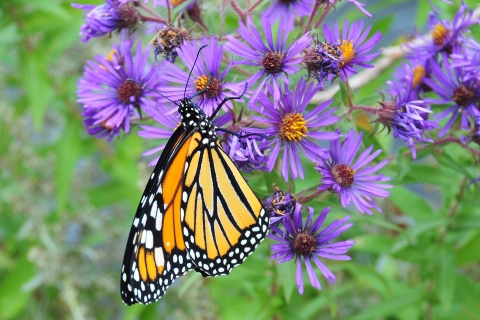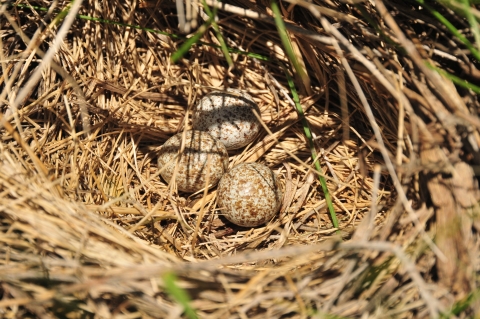What We Do
Wildlife conservation is at the heart of the National Wildlife Refuge System. It drives everything on U.S. Fish and Wildlife Service lands and waters managed within the Refuge System, from the purposes for which a national wildlife refuge national wildlife refuge
A national wildlife refuge is typically a contiguous area of land and water managed by the U.S. Fish and Wildlife Service for the conservation and, where appropriate, restoration of fish, wildlife and plant resources and their habitats for the benefit of present and future generations of Americans.
Learn more about national wildlife refuge is established to the recreational activities offered to the resource management tools used. Using conservation best practices, the Refuge System manages Service lands and waters to help ensure the survival of native wildlife species.
Upland habitat management is geared toward providing tall and dense nesting cover on a high percentage of uplands for nesting birds, especially waterfowl. Rejuvenation of decadent grasslands and the control of invasive plant species are accomplished through an active management program of grazing, prescribed burning, haying, farming, reseeding, invasive plant control, and habitat monitoring. Grasslands are categorized as dense nesting cover, introduced cool season grasses, and seeded native grasses. Vegetative structure differs greatly between the three habitat types resulting in different management objectives.
The grassland vegetation of the northern Great Plains evolved under periodic disturbance and defoliation from bison and fire. This periodic disturbance is what made the prairie healthy and a place of enormous diversity for thousands of years. Fire in grassland ecosystems is essential for maintaining healthy vegetation in grasslands, wetlands, and some woodlands for wildlife habitat. Refuge staff conduct prescribed fire management treatments on selected units of the refuge replicating historic wildfire events that benefit prairie landscapes. Domestic cattle are used in prescribed grazing treatments on selected refuge units to also improve grasslands, control invasive species invasive species
An invasive species is any plant or animal that has spread or been introduced into a new area where they are, or could, cause harm to the environment, economy, or human, animal, or plant health. Their unwelcome presence can destroy ecosystems and cost millions of dollars.
Learn more about invasive species and increase plant diversity.
Wetland management is largely dependent on flows of the James River. High springtime flows generally result in adequate filling of Mud Lake and Sand Lake and these pools can be maintained at a full pool elevation. Periodic drawdowns are very beneficial to wetland management and are attempted when lower flows permit. The refuge has large concentrations of over water nesting species such as Franklin’s gulls, White-faced ibis, black-crowned night heron, eared grebe, western grebe and Forster’s terns.
Standardized ground and aerial wildlife surveys and vegetation surveys are conducted throughout the year to inventory populations and document habitat use. Units are evaluated by how well they met habitat and wildlife use objectives.
Management and Conservation
Refuges deploy a host of scientifically sound management tools to address biological challenges. These tools span active water management to wilderness character monitoring, all aimed at ensuring a balanced conservation approach to benefit both wildlife and people.
Our Projects and Research
Science sets the foundation for how fish, wildlife, plants and their habitats are managed at Sand Lake National Wildlife Refuge. In cooperation with other researchers, universities and science-based organizations we have created a broad-based platform in our ecological research to implement management strategies that are best suitable for entire landscapes and ecosystems, rather than a single species.
Law Enforcement
Law Enforcement at Sand Lake National Wildlife Refuge Complex helps visitors enjoy the Refuge and understand and obey wildlife and resource protection laws. Officers also play a key role in the successful management of refuge lands and maintaining high quality visitor experiences.
Laws and Regulations
There are many activities to enjoy while visiting Sand Lake, but to minimize disturbance to wildlife and to ensure visitor safety there are certain rules and regulations to follow while visiting.
National Historic Preservation Act of 1966
The National Historic Preservation Act of 1966 directs Federal agencies to preserve, restore, and maintain historic cultural environments.
National Wildlife Refuge System Administration Act
The National Wildlife Refuge System Administration Act provides authority, guidelines and directives for the Service to improve the National Wildlife Refuge System; administers a national network of lands and waters for the conservation, management, and restoration of fish, wildlife and plant resources and habitat; ensures the biological integrity, diversity, and environmental health of refuges is maintained; defines compatible wildlife-dependent recreation as appropriate general public use of refuges; establishes hunting, fishing, wildlife observation and photography, and environmental education as priority uses; establish a formal process for determining compatible uses of refuges; and provide for public involvement in developing comprehensive conservation plans for refuges.
National Wildlife Refuge System Improvement Act
The National Wildlife Refuge System Improvement Act spells out wildlife conservation as the fundamental mission of the refuge system; requires comprehensive conservation planning to guide management of the refuge system; directs the involvement of private citizens in land management decisions; and provides that compatible wildlife-dependent recreation is a legitimate and appropriate use that should receive priority in refuge planning and management.
National Wildlife Refuge Volunteer Improvement Act
The National Wildlife Refuge Volunteer Improvement Act authorizes cooperative agreements with nonprofit partner organizations, academic institutions, or State and local governments to construct, operate, maintain, or improve refuge facilities and services, and to promote volunteer, outreach, and education programs.


